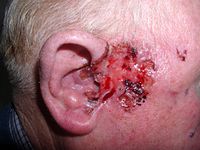
Photo from wikipedia
Purpose Anal mucosal melanoma is an uncommon malignancy of the anal canal, with few large studies available to establish clear trends in the treatment modalities presently available. The primary goal… Click to show full abstract
Purpose Anal mucosal melanoma is an uncommon malignancy of the anal canal, with few large studies available to establish clear trends in the treatment modalities presently available. The primary goal of this study was to identify the patterns of care in the treatment of anal melanoma and secondarily to determine outcomes. Methods This was a retrospective study performed utilizing the National Cancer Database (NCDB). A total of 787 patients diagnosed with anal melanoma between 2004 and 2014 were selected, of which 398 had staging information. The four treatment groups analyzed were surgical excision alone, surgical excision and radiation therapy, surgical excision and immunotherapy/chemotherapy, and radiation therapy plus minus immunotherapy/chemotherapy. Treatment was grouped by extent of disease; the Kaplan-Meier method was used to analyze overall survival and multivariate Cox proportional model was used to identify factors associated with overall survival. Results The majority of patients presented with either node-positive (39.4%) or metastatic disease (37.4%). Patients with surgical excision and radiation therapy had the highest median survival at 32.3 months. This is in contrast with those receiving surgical excision alone (22.9 months), surgery and immunotherapy/chemotherapy (18.4 months), and radiation without surgery (5.1 months) ( p < 0.0001). Conclusions Treatment with surgical excision was the most common initial treatment with no single modality superior over another in this rare entity.
Journal Title: Journal of Gastrointestinal Cancer
Year Published: 2019
Link to full text (if available)
Share on Social Media: Sign Up to like & get
recommendations!